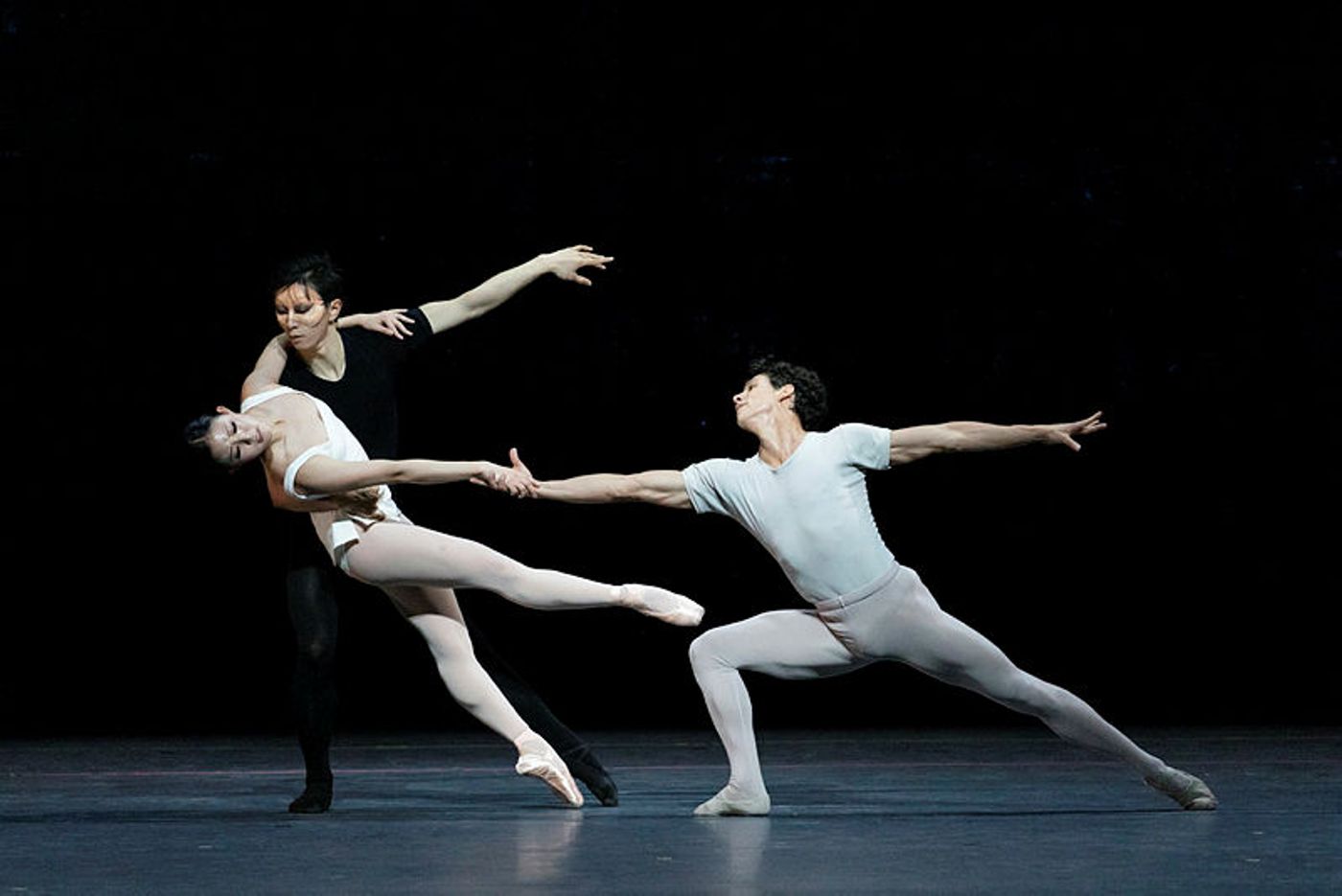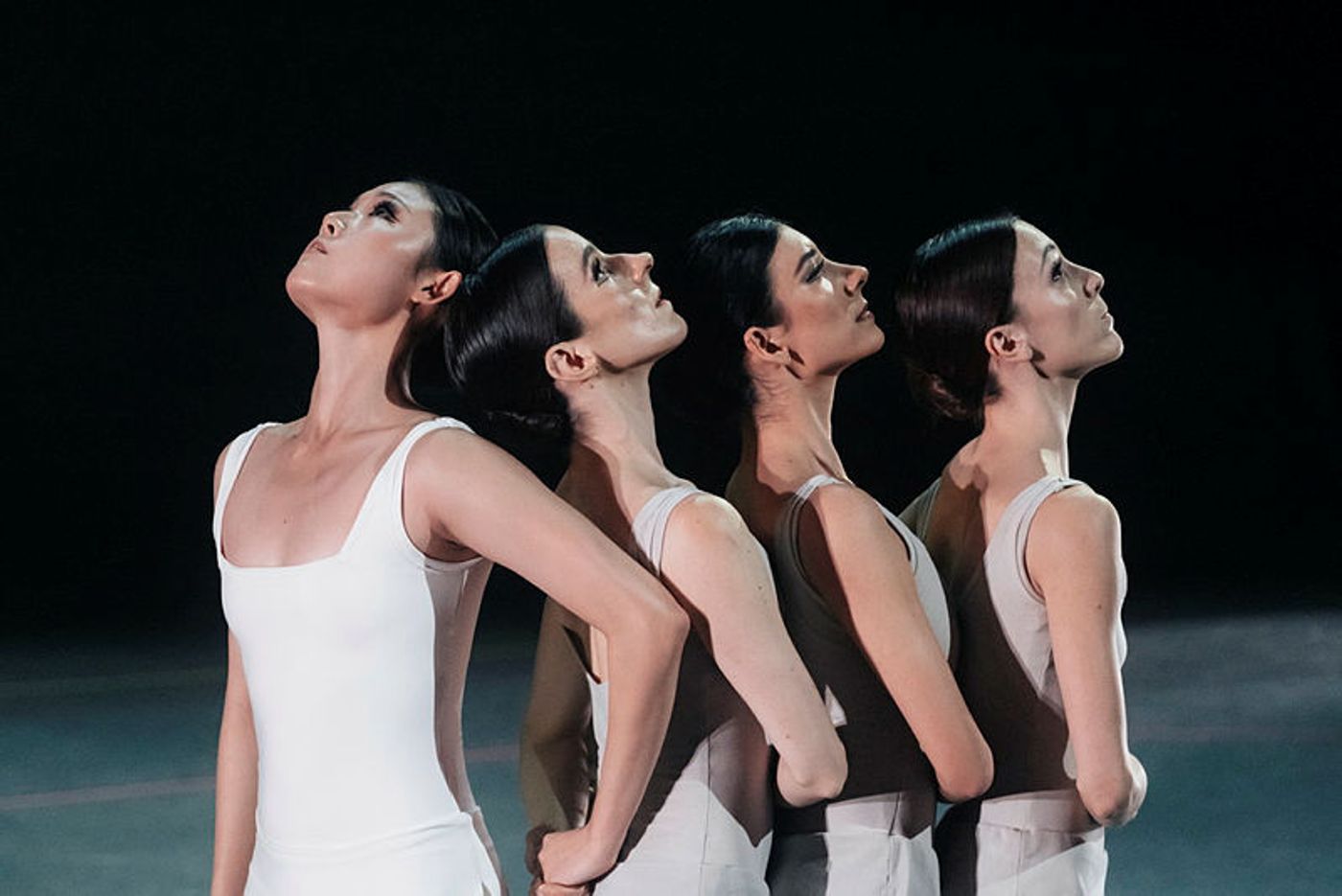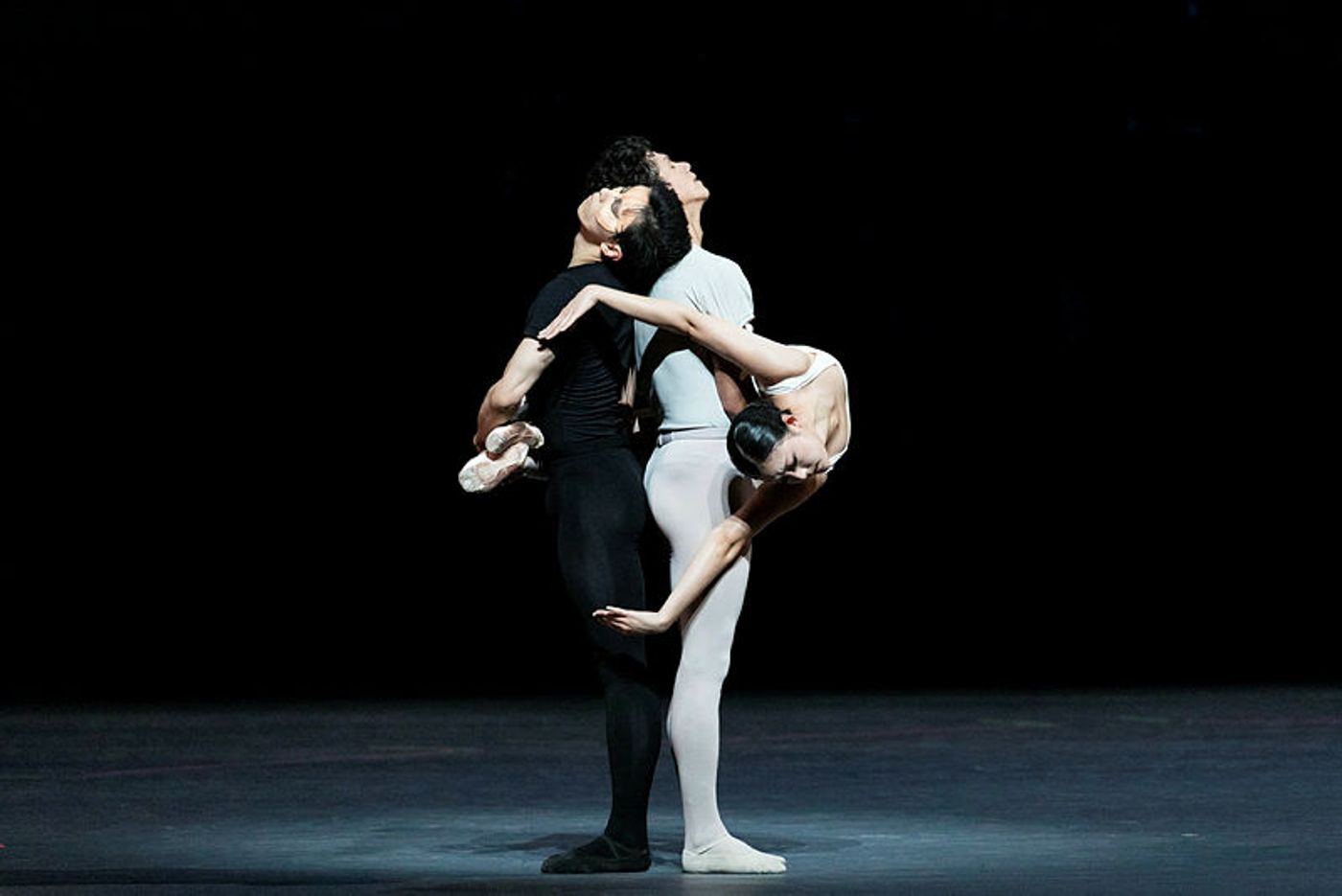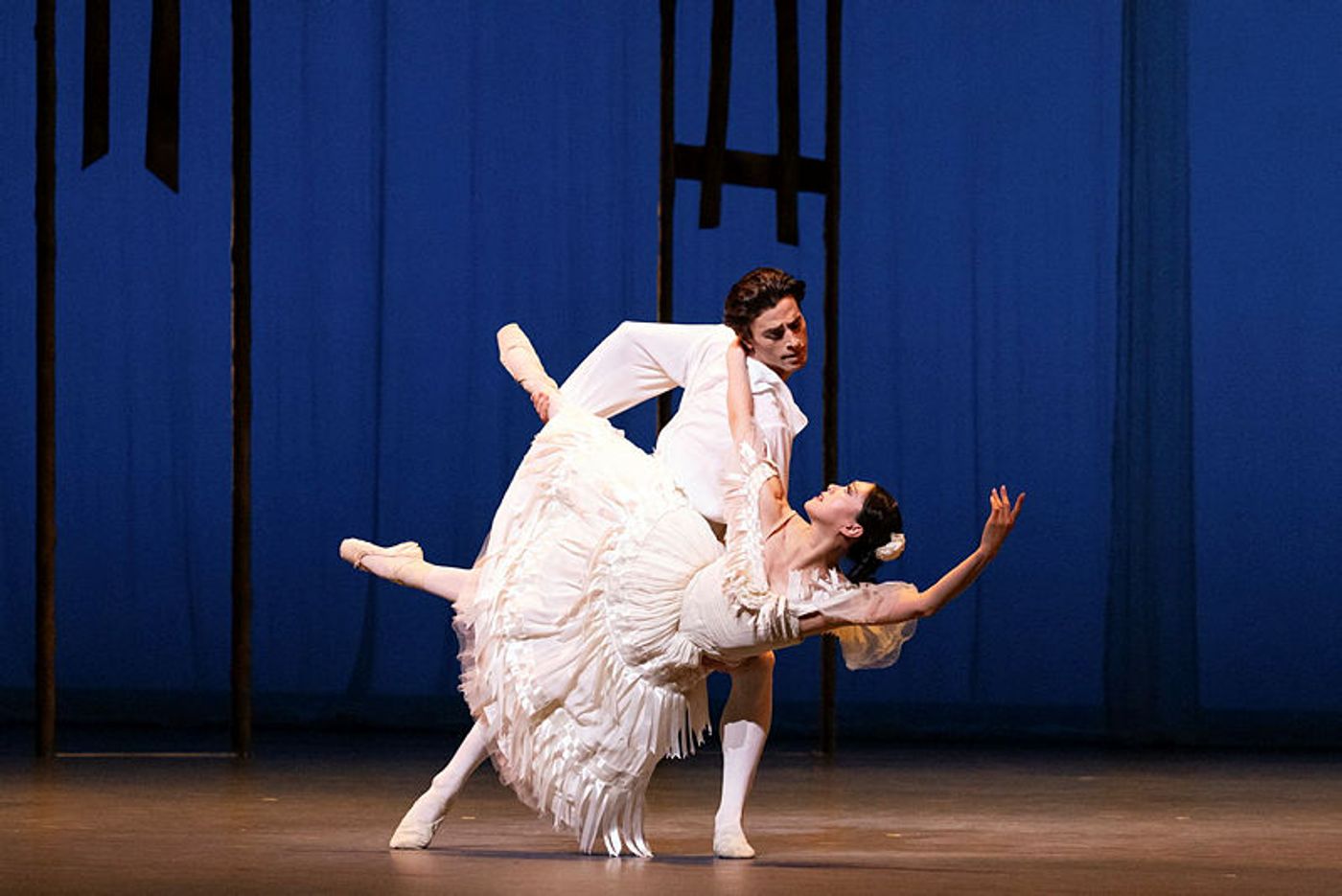Review: BRITISH ICONS at San Francisco Ballet
The immensely rewarding program runs through February 15th at the War Memorial Opera House

in Kenneth MacMillan's Song of the Earth at San Francisco Ballet
(photo by Reneff-Olson Productions)
A couple of years ago when it was announced that Tamara Rojo had been appointed as San Francisco Ballet’s new Artistic Director and that she hailed from the Royal Ballet and the English National Ballet, my first thought was, “Ooh, maybe we’ll get to see some Ashton and MacMillan!” SFB had danced works by these two masters of British ballet only infrequently in recent years and the results were usually a tad mixed, as though something had gotten lost in translation. Well, the moment I’d longed for has now arrived with SFB’s richly-rewarding British Icons program comprised of Kenneth MacMillan’s Song of the Earth and Frederick Ashton’s Marguerite and Armand. I’m happy to report that it was well worth the wait.
Song of the Earth from 1965 opens the program and is the longer and more substantial of the two. It uses Mahler’s monumental Das Lied von der Erde, a song cycle set to Chinese Tang dynasty poetry loosely translated into German by the poet Hans Bethge. The text is a meditation on the transience of life amid the earth’s profound beauty and the ballet’s main characters are called simply a Man, a Woman and a Messenger of Death. While that description might make the ballet sound almost hopelessly obtuse, the good news is that you can also feel free to disregard any of that and just let the work wash over you in one entrancing sequence after another. It’s ultimately a captivating exploration of what it means to be alive.
Song of the Earth had me from the downbeat when four men bounded onstage to Mahler’s turbulent fanfare where they met up with a glorious tenor soloist. As the work progresses, teams of male and female dancers enter the fray as the main characters are introduced and the mood keeps shifting between joyous, meditative, sad and mysterious. What follows over the course of six songs is the development of a very complicated triangular relationship at the center of this community. The Death figure is both subtly ominous and benignly non-threatening, alternately part of and apart from the world depicted. Nicholas Georgiadis’ simple black, white and soft grey costumes and his striated charcoal backdrop against Jacopo Pantiin’s understated lighting keep the focus right where it should be – on the dancers themselves.

in Kenneth MacMillan's Song of the Earth at San Francisco Ballet
(photo by Lindsay Rallo)
MacMillan’s choreography seems more interested in capturing the mood of the music rather than directly interpreting the text, and his movement is clean, crisp and understated, which plays perfectly to the natural strengths of the SFB dancers. They make the movement compelling without gilding the lily, and their musicality is so strong that they are able to clearly articulate MacMillan’s unusual shapes and connect them into unbroken phrases. There is still plenty of bravura dancing along the way, but it never announces itself with a big “ta-da!.” MacMillan’s extensive use of gesture, stillness vs. liveliness, and simple walking steps seems to prefigure later works by American master choreographers such as Paul Taylor and Mark Morris. His occasional use of gently cocked heads and flexed feet mirrors the East Asian influence of Mahler’s employment of pentatonic scales and of course the poems that were his initial inspiration. It’s a fascinating stew of multiculturalism that keeps you guessing every step of the way what’s going to happen next. Even at a lengthy 65 minutes, the momentum never flags.
SFB couldn’t have given it a better performance on opening night. The corps de ballet of eleven danced with such crisp authority and air of mystery that I could easily imagine them stepping up to the more featured roles danced so beautifully by Katherine Barkman, Cavan Conley, Luca Ferrò, Jasmine Jimison, Joshua Jack Price and Julia Rowe. All were scintillating in their individuality and sense of inner life they brought to the movement.
Isaac Hernández was quite intriguing as the Man, impressive in the way he subtly pointed up the more stylized aspects of the choreography. Wona Park as the Woman was even more beguiling, so specific in the detail of her steps and enigmatic in her demeanor. She had a series of backward bourrées across the entire width of the stage and then back again that were otherworldly in their contrasting sharpness and delicacy. When she fearlessly bounded sideways into the arms of and Hernández and Wei Wang just before the end, it felt like an act of grace, rather than just bravado.

in Kenneth MacMillan's Song of the Earth at San Francisco Ballet
(photo by Reneff-Olson Productions)
And speaking of Wang, he was spectacular. He has a special gift for breathing life into tricky roles that cast him as the “other,” be it Frankenstein, John the Baptist, or here as the Messenger of Death. His performance gradually gets under your skin as he rides that fine line between being part of, and not part of, the central relationship and the larger community. One moment he seems like just one of the guys, the next he’s a vaguely unnerving interloper, quietly observing as he skirts the periphery. He is always so fascinating as a presence that you keep wondering “What is this guy’s deal?” When he arrives in a flash at the very end of the third song only to whisk Jasmine Jimison off into the wings, it’s both antic and unsettling. Such a complicated performance! Wang also showed off his expert partnering skills in the second song by repeatedly lifting Park in a way that gave the illusion she was levitating over the stage.
And I haven’t even mentioned the gorgeously nuanced vocals of tenor Moisés Salazar and mezzo soprano Gabrielle Beteag. Maybe it’s because the singers were placed onstage rather than in the pit, but I felt it allowed the dancers to become one with the music, to really live in the moment more than they usually do. All in all, it was a sublime performance that was so intensely pleasurable to watch that I can’t wait to see it again so I can delve deeper into its mysteries.

Frederick Ashton's Marguerite and Armand at San Francisco Ballet
(photo by Reneff-Olson Productions)
After intermission, Ashton’s Marguerite and Armand wasn’t up to that same standard, more of a historical curiosity than a work of substance. It’s the ballet that Ashton in 1963 chose to choreograph specifically to celebrate the new dream team of Margot Fonteyn and Rudolf Nureyev shortly after the latter had defected to the West. As such, it was specifically designed to capitalize on their unique talents and alchemy (in a reverse of Katharine Hepburn’s famous quip about Astaire & Rogers, she gave him class and he gave her sex appeal), not to mention the drama surrounding Nureyev’s decision to leave the Soviet Union. Not surprisingly, the ballet doesn’t really come with the same frisson some 60 years on when danced by others, even ones as good as SFB offered on opening night.
Set to Liszt’s B Minor Piano Sonata, the ballet is a barnburner of a melodrama about the illicit romance of a consumptive courtesan and her dashing young lothario that inevitably ends with her death. There’s a lot of flashy dancing both characters run the gamut of emotions in just over a half-hour. It’s all bit much, and for contemporary audiences perhaps a bit musty and a little kitschy. I also wasn’t thrilled with the scenic and costume design by no less than the estimable Cecil Beaton. The use of blowup images of the two lovers at the beginning looked a little cheesy, and Marguerite’s gowns are so over-embellished they obscure the line of her body. In a ballet this brief, there is also too much dead space between scenes to allow for the leading ballerina’s multiple change costumes.

Frederick Ashton's Marguerite and Armand at San Francisco Ballet
(photo by Reneff-Olson Productions)
Joseph Walsh gave it a good shot as Armand, dancing with skill and commitment, but there’s not a lot this terrific dancer can to do to create a fully-realized character out of such thin material. Misa Kuranaga as Marguerite was a bit of a cypher at first, but seemed to blossom into the role once Marguerite’s health began to fail, and she was exquisite in the death scene. Still and all, asking any dancer to take on these iconic assignments is a tall order, and I was truly grateful for the opportunity to finally see this famous Ashton ballet performed live onstage. In coming seasons, would it be too much to hope we get to see some of Ashton’s stronger works, like Symphonic Variations (not danced by SFB in many years) or one of his highly-regarded full-length ballets?
(Header photo by Lindsay Rallo)
---
San Francisco Ballet’s British Icons program continues through Thursday, February 15th at the War Memorial Opera House, 301 Van Ness Avenue, San Francisco, CA. Running time is approximately two hours and five minutes, including one intermission. For tickets and additional information, visit www.sfballet.org or call (415) 865-2000, M-F 10am-4pm.
Reader Reviews
Videos

